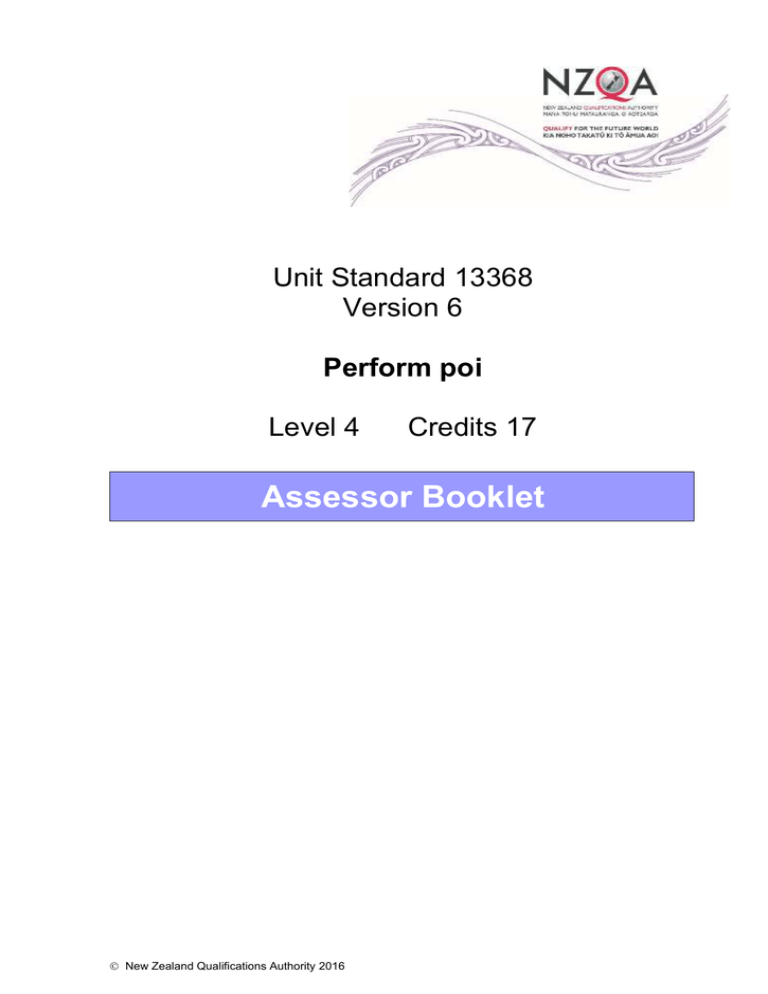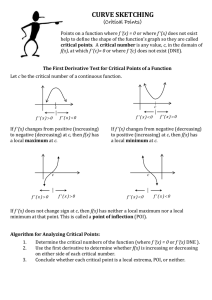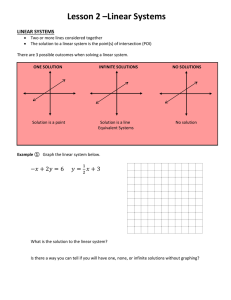Assessment Guide (DOCX, 321KB)
advertisement

Unit Standard 13368 Version 6 Perform poi Level 4 Credits 17 Assessor Booklet New Zealand Qualifications Authority 2016 Unit Standard 13368 Version 6 – Perform poi Level 4 Credits 17 Assessor Information This unit standard can be awarded with Paetae/Achieved, Kaiaka/Merit and Kairangi/Excellence grades. Assessment criteria Paetae/Achievement Achievement with Kaiaka/Merit Achievement with Kairangi/Excellence Demonstrate knowledge of the pūtake and tikanga of poi, and perform poi. Demonstrate in-depth knowledge of the pūtake and tikanga of poi, and perform poi with expression and projection. Demonstrate comprehensive knowledge of the pūtake and tikanga of poi, and perform poi with artistic proficiency. There are TWO (2) assessment tasks that the ākonga must correctly complete to gain credits for this standard. Once the ākonga has correctly completed the tasks, the assessor must complete the assessment schedule for each ākonga. Please remember that the focus is Māori performance! Nō reira: the most effective activities for assessment will be those that are practical or performance based written tests should be discouraged assessments can occur in a range of contexts, e.g. marae, school, classroom, practices or other learning contexts kapa haka competitions can be used to assess Outcome 2 of this unit standard local haka experts and/or exponents may be used to assess ākonga. Ākonga assessment booklet The ākonga receives this. It outlines important information for the ākonga including: assessment and other information assessment tasks. Ākonga assessment task sheets These sheets and any other evidence should be collected by the Assessor and retained for assessment and moderation purposes. Where ākonga chooses to provide oral description/evidence for Task 1 (Outcome 1), this must be recorded. Where ākonga work has been selected for moderation, the recorded evidence must be included with the materials. Page 2 of 10 New Zealand Qualifications Authority 2016 Unit Standard 13368 Version 5 – Perform poi Level 4 Credits 17 You will need to discuss with the ākonga the length of time they have to complete the assessment. He ture-a-kōnui: one credit equates to 10 notional hours of teaching and assessment. Evidence of Task 2 (Outcome 2) must be recorded. Where ākonga work has been selected for moderation, the recorded evidence must be included with the materials. Where recorded evicence is submitted for moderation, the ākonga identification sheet (refer following link: http://www.nzqa.govt.nz/qualificationsstandards/qualifications/ncea/subjects/preparing-digital-visual-submissions-formoderation/) must be included. Authenticity As per NZQA requirements: you must verify that the work submitted for assessment has been produced by the ākonga you must consider (and manage) the potential for work to have been copied, borrowed from another ākonga, photocopied from a book or downloaded from the internet. It is okay for ākonga to work with and learn from others to gather information from a variety of sources. However, you must be clear that the work to be assessed has been processed and produced by the ākonga. To help manage authenticity of ākonga work, where the ākonga is asked to complete any written tasks, the ākonga is asked to use their own words as well as provide reference/s for their information. Please ensure you discuss this with your ākonga. For further information, please refer to the following link: http://www.nzqa.govt.nz/providers-partners/assessment-and-moderation/assessmentof-standards/generic-resources/authenticity/ Referencing This assessment requires the ākonga the reference his/her information. For the purposes of this assessment, the following are examples of reference styles. However, you may want to change the style. Examples of referencing: Book: Author last name, Initial. (Year book was published), Name of Book, Publication City and Country: Publisher. e.g. Pōtiki, M. (1995) Haka Mana Para Tawa Ngāwhā. Kaitaia, New Zealand: Kauae Runga Publishers. Webpages: reference the homepage. e.g. http://www.hakamanaparatawangawha.co.nz Page 3 of 10 New Zealand Qualifications Authority 2016 Unit Standard 13368 Version 5 – Perform poi Level 4 Credits 17 Course hand out/Lecture notes: Lecturer/Teacher last name, Initial. (Year of course/lecture). Course title: [PowerPoint Slides]/[Video]/[Lecture notes]. City, Country: Venue. e.g. Knowles, B. (2012). MPA class: [Te Wakahuia Video]. Piopiotahi, New Zealand: Piopiotahi College. Preparation for moderation Form 1 Attached for moderation* Moderation cover sheet. This should include the ākonga identifier and grades. Secondary refer following link: http://www.nzqa.govt.nz/assets/Providers-and-partners/Assessmentand-moderation/sec-mod-cvrsheet-random.doc Tertiary refer following link: http://www.nzqa.govt.nz/assets/Providers-and-partners/Assessmentand-moderation/Tertiary-Moderation/Tertiary-moderation-coversheet.doc 2 Copy of unit standard. Please ensure the version of the standard reflects the version used in the assessment task. 3 Blank copy of assessment task and assessment schedule. 4 Copy of ākonga samples (completed assessment tasks). 5 Standards with Kaiaka/Merit and Kairangi/Excellence grades, submit EIGHT samples of ākonga work. Visual/digital evidence cover sheet: http://www.nzqa.govt.nz/assets/Providers-and-partners/Assessmentand-moderation/mod-visevidence-cvr.doc Please remember: you cannot send Blueray discs, Hi8, DV or MiniDV tapes, or HD files for moderation. Remember to test the recording device to ensure that it can be read in another device. Please refer following link for further information: http://www.nzqa.govt.nz/qualificationsstandards/qualifications/ncea/subjects/preparing-digital-visualsubmissions-for-moderation/ TIP: You should start preparing the materials for moderation at least one month before the submission date. This will give you time to locate all the relevant and necessary forms and sheets. If you have any issues with preparing materials for moderation OR do not have materials to submit (ie, you didn’t assess this standard), SPEAK to your Principal Nominee (PN) or Moderation Liaison (ML). Page 4 of 10 New Zealand Qualifications Authority 2016 Unit Standard 13368 Version 5 – Perform poi Level 4 Credits 17 Assessor information – assessment tasks Outcome 1 Demonstrate knowledge of the tikanga and pūtake of poi. Assessment Task 1 –Tikanga and pūtake Describe the tikanga and pūtake of FOUR poi, each from different categories, in accordance with iwi traditions. The categories of poi are: single short poi, double short poi, single long poi, double long poi The information must be in ākonga’s own words and references must be provided. This task assesses the evidence requirements of 1.1. 1.1 Pūtake and tikanga of poi from different categories are described in accordance with iwi traditions. Evidence of all FOUR categories is required. Sample answer that would be acceptable for ‘Kairangi/Excellence. Poi One Name Pākete Whero Category Single Short Poi Composer name Ihapera (Isabella) Thom (Guide Bella Papakura) Composer iwi Tūhourangi Date poi was composed Early 1900’s Why poi was composed This poi action song has been famous at Whakarewarewa since the early 1900s. It was listed in the program of a 1910 concert organised by Maggie and Bella Papakura. Bella is said to have composed this song in honour of a man from Ruatāhuna that she was secretly having an affair with. The wearing of the red scarves by both of them signalled to each other their secret love. (Paringatai 2004) A Whakarewarewa guide from the 1930s, Bubbles Mihinui, explains: "It used to be a special song sung by the Whaka(rewarewa) guides. Bella composed a poi to this song for the 1934 Waitangi Day celebrations. For a long time only the guides at Whaka(rewarewa) could perform it, because 'Pakete whero' has got an offbeat. Bella made her poi sound like the hoof beats of galloping horses - she loved the races." This poi blended aspects of Māori composition (innuendo about a secret love is often a feature of waiata) with European technique (the fast paced off-beat poi rhythms based on galloping horses). Page 5 of 10 New Zealand Qualifications Authority 2016 Unit Standard 13368 Version 5 – Perform poi Level 4 Credits 17 It was a "poi waka," designed to satisfy the 1900s Rotorua tourist market. The Whakarewarewa Thermal Area guides had turned to organising concert performance parties to increase their income, and Guide Bella in particular quickly honed her poi skills. She took poi to new levels of performance that were based on a mix of traditional conventions and modern practices, and in doing so created styles that quickly became widespread. Tarapounamu / tara pounamu Tarapounamu is a mountain peak east of Ruatahuna, the home of Bella's lover. It was so named when Tamatea Kaitaharuahe speared a pigeon there in the mid 1600s. The valuable greenstone point on his bird spear become detached from the shaft, and the bird flew away with the point sticking in its body. Tamatea somehow managed to follow the bird for miles across the ranges and eventually recovered his tara pounamu. Bella is implying she was that pigeon, and she is also making some wordplay on the words "tara" and "pounamu" to sum up her feelings after being with him. "Tara" has several meanings: it can be a spike or spear tip, and thus it is used as a colloquial term for the penis. "Tara" also describes the side walls between two houses, and so it is sometimes used as a term for the vagina. "Tatau pounamu," a door of greenstone, is a metaphor for enduring peace. Greenstone carvings were beautiful and everlasting and were exchanged as symbols of peace. So by using a variant of this phrase, "tara pounamu," a sexual organ of greenstone, Bella describes the feeling of utter peace she experienced after she and her lover gifted their sexuality to each other. Pākete whero Ma-u mai a koe Mā-ku e here Ka tino pai rawa e The red scarf you are wearing matches mine. How totally delightful! In 1905, guides in the Rotorua thermal area wore red headscarves. Bella's lover wore a red kerchief round his neck. Hoatu koe kei mua Hinemoa Tīriti Ko au kei muri Kei mātauria You go in front down Hinemoa Street I walk along behind lest our secret becomes known. Hinemoa Street led to a lakeside reserve with secluded places where lovers could meet He rau koikoi Tō whārikiriki He rau toromiro Tō pēra o runga e Soft pink fern leaves are your bed-mat and miro leaves your pillow. Tō pikitanga Taumata te Rāiti. Tō heketanga Ko tara pounamu e Your ascent brings an explosion of light. Your descent brings peaceful intimacy Koi-koi or Ki-o-ki-o, a tiny soft fern Blechnum minus. Toromiro or Miro, a large tree Prumnopitys ferruginea. A description of their lovemaking Ref: http://folksong.org.nz/pakete_whero/index.htm NB: your ākonga has been asked to provide references. Where you have referred to a book, or website, or person, please acknowledge this in your lessons. Page 6 of 10 New Zealand Qualifications Authority 2016 Unit Standard 13368 Version 5 – Perform poi Level 4 Credits 17 Outcome 2 Perform poi Assessment Task 2 – Performance Perform FIVE poi items, covering all four categories. The items must display ihi, wehi and wana in accordance with iwi tradition and/or the pūtake of each poi. The categories of poi are: single short poi, double short poi, single long poi, double long poi This task assesses the evidence requirements of 2.1. 2.1 Poi is performed in accordance with iwi tradition, and/or the pūtake of the poi. 2.2 Poi is performed displaying evidence of ihi, wehi and wana. I te ākonga e poi ana: mō Paetae/Achieved, me: matatau ia ki n gā kupu tika te mita o tōna reo, tōna whakahua i ngā kupu, me tōna hā tika tōna whai i te rangi hāngai tōna tū, me te kori i tōna tinana/mahi-ā-ringa, ki te/ngā tikanga me te pūtake o te poi. mō Kaiaka/Merit, me: pūmau ki te tangi me te wairua o te rangi hāngai pū te kori o tōna tinana ki te wairua me ngā kupu o te poi, ā, kia tika tōna tū. mō Kairangi/Excellence, me: pakari te tū me te korikori o tōna tinana, ā, puta ana ngā mahi auaha ū pūmau ki te wairua o te rangi mai i te tīmatanga ki te whakamutunga puta pū te wairua o ngā kupu, ā, me tōna tinana hoki, mai i te tīmatanga ki te whakamutunga tika te mahi tahi o ōna ringa me te kori o te tinana eke ki te tihi o te poi, rangona ai te hā o kui mā, o koro mā A checklist for this task has been provided for you on the following page. This may help when you complete the assessment schedule. Please ensure one checklist is used per poi. You will need to photocopy extra copies of the checklist. Page 7 of 10 New Zealand Qualifications Authority 2016 Unit Standard 13368 Version 5 – Perform poi Level 4 Credits 17 Outcome 2 – Assessor checklist: Ākonga performance Ākonga Poi item Date Requirements Performance criteria Category (please tick) Tick relevant box. single short poi double short poi Tutor comments Kua matatau ki ngā kupu. Kua tika te mita o te reo, te whakahua i ngā kupu, me te hā. Kua tika te whai i te rangi. single long poi double long poi Kua hāngai te tū, me te kori i te tinana/mahi-ā-ringa ki te/ngā tikanga me te pūtake o te poi. Paetae/Achieved __________________ Poi item is performed. Kua pūmau ki te tangi me te wairua o te rangi Kua hāngai pū te kori o te tinana ki te wairua me ngā kupu o te poi, ā, kia tika te tū. Kaiaka/Merit Kua pakari te tū me te korikori o te tinana, ā, puta ana ngā mahi auaha Kua ū pūmau ki te wairua o te rangi mai i te tīmatanga ki te whakamutunga Kua puta pū te wairua o te kupu, ā, me te tinana hoki, mai i te tīmatanga ki te whakamutunga Kua tika te mahi tahi o te ringa me te kori o te tinana Kua eke ki te tihi o te poi, rangona ai te hā o kui mā, o koro mā. Kairangi/Excellence Page 8 of 10 New Zealand Qualifications Authority 2016 Unit Standard 13368 Version 5 – Perform poi Level 4 Credits 17 ASSESSMENT SCHEDULE Task 1 – Describe the tikanga and pūtake of FOUR poi, each from different categories, in accordance with iwi traditions. Evidence for Paetae/Achievement Evidence for Achievement with Kaiaka/Merit Evidence for Achievement with Kairangi/Excellence Grade It is expected that ākonga samples will vary, according to iwi traditions. However, the following components should be included in ākonga responses: As per Paetae/Achievement, plus: As per Kaiaka/Merit, plus: Please tick: the category matches the poi the composer is identified, and his/her iwi is/are identified the name of the poi is identified when and why the poi was composed the words and translation of the poi described the pūtake and tikanga of each poi associated with its particular category explained the background kōrero to the composition of each poi explained each poi in terms of the significance to the whānau, hapū, and/or iwi to whom they belong, refer to, and/or are sung by described any personal (to the composer), social, cultural, political, economic, or geographical issues or influencing factors of the time that led to the composition of the poi N A M E Examples of referencing: Book: Book: Pōtiki, M. (1995) Haka Mana Para Tawa Ngāwhā. Kaitaia, New Zealand: Kauae Runga Publishers. Webpage: http://www.hakamanaparatawangawha.co.nz Course hand out/Lecture notes: Knowles, B. (2012). MPA class: [Te Wakahuia Video]. Piopiotahi, New Zealand: Piopiotahi College. Judgement for Paetae/Achieved Judgement for Kaiaka/Merit Judgement for Kairangi/Excellence Grade The pūtake and tikanga of FOUR poi categories are correctly described. Reference/s is/are provided. Page 9 of 10 New Zealand Qualifications Authority 2016 Unit Standard 13368 Version 5 – Perform poi Level 4 Credits 17 Task 2 – Perform FIVE poi items, covering all four categories. The items must display ihi, wehi and wana in accordance with iwi tradition and/or the pūtake of each poi. Evidence for Paetae/Achievement Evidence for Paetae/Achievement with Kaiaka/Merit Evidence for Paetae/Achievement with Kairangi/Excellence Grade Ka whakaatu te ākonga: As per Paetae/Achievement, plus: As per Kaiaka/Merit, plus: Please tick kua matatau ki ngā kupu kua tika te mita o te reo, te whakahua i ngā kupu me te hā kua tika te whai i te rangi kua hāngai te tū, me te kori i te tinana/mahi-ā-ringa ki te/ngā tikanga me te pūtake o te poi. kua pūmau ki te tangi me te wairua o te rangi kua hāngai pū te kori o te tinana ki te wairua me ngā kupu o te poi, ā, kia tika te tū. Judgement for Paetae/Achieved Judgement for Kaiaka/Merit kua pakari te tū me te korikori o te tinana, ā, puta ana ngā mahi auaha kua ū pūmau ki te wairua o te rangi mai i te tīmatanga ki te whakamutunga kua puta pū te wairua o te kupu, ā, me te tinana hoki, mai i te tīmatanga ki te whakamutunga kua tika te mahi tahi o te ringa me te kori o te tinana kua eke ki te tihi o te poi, rangona ai te hā o kui mā, o koro mā. N A M E Judgement for Kairangi/Excellence FIVE poi items, covering all four categories, are performed. Overall grade (please circle) N (Not Achieved) A (Paetae/Achieved) Ākonga name Assessor name Ākonga signature Assessor signature M (Kaiaka/Merit) E (Kairangi/Excellence) Completion date Page 10 of 10 New Zealand Qualifications Authority 2016


